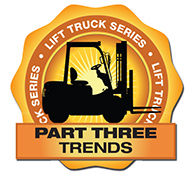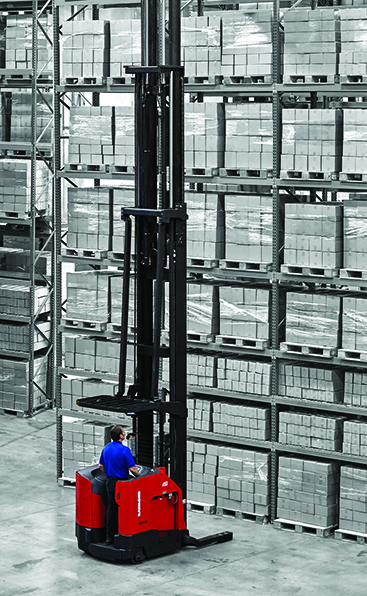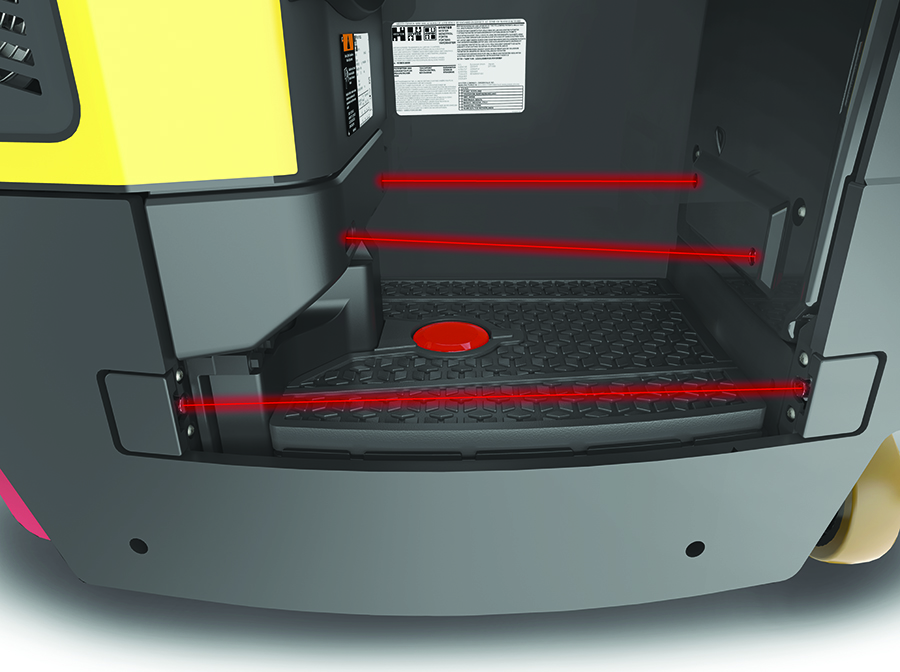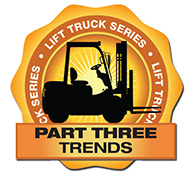 While certain features on lift trucks come and go, three constants remain: safety, ergonomics and maintenance. Ultimately, that trio is all about reducing wear and tear on lift truck operators and the equipment itself. All three are focused on making both trucks and their operators highly valued productivity resources in the plant and warehouse.
While certain features on lift trucks come and go, three constants remain: safety, ergonomics and maintenance. Ultimately, that trio is all about reducing wear and tear on lift truck operators and the equipment itself. All three are focused on making both trucks and their operators highly valued productivity resources in the plant and warehouse.
This brings up an interesting question: After all these years, how much can really be new here? More than you might expect in all likelihood. Chances are that it’s been some time since you last leased or bought a lift truck. Meanwhile, suppliers have continued to make improvements in these three key areas.
For instance, are your current counterbalanced trucks outfitted with cameras for more precise load positioning especially at heights above 30 feet? Do your trucks use sensors instead of dead man pedals for safety? Are you still living in a world of run-it-until-it-breaks, or have you moved on to usage-based preventative or even predictive maintenance?
 And the list of updates goes on. Here’s a rundown on what some of the leading lift truck suppliers say matters most today when it comes to safety, ergonomics and maintenance.
And the list of updates goes on. Here’s a rundown on what some of the leading lift truck suppliers say matters most today when it comes to safety, ergonomics and maintenance.
One of the best safety stories in all of industry has nothing to do with lift trucks. Yet, it is highly relevant.
In 1987, Paul O’Neill was introduced at a press conference as the new CEO of Aluminum Company of America (Alcoa). And then, he opened his mouth. “I want to talk to you today about worker safety. I intend to make Alcoa the safest company in America.” Wall Street analysts were baffled. He said nothing about a profit strategy.
In fact, safety was O’Neill’s profit strategy for reviving the lagging aluminum producer. When O’Neill left years later, he was considered a hugely successful leader even by those who wrote him off initially. O’Neill, as it turned out, knew that safety is a secret weapon.
Brian Feehan, president of the Industrial Truck Association (ITA), couldn’t agree more. “We need a culture of safety, and it has to be a 365-day-a-year effort,” he says.
To promote that, the ITA has for the past seven years held a National Forklift Safety Day on the second Tuesday of June. This year, more than 350 attendees of the virtual event heard from experts from the lift truck industry and OSHA. “The idea,” says Feehan, “is to raise awareness of the critical importance of operator training for lift truck safety as well as pedestrian safety.” To view the event, visit indtrk.org/national-forklift-safety-day.
The importance of every day lift truck safety is not lost on Melissa Fent, Crown’s lift truck operator training manager. “Training is a foundational element to building a safety culture. It is not just a thing you do but the heart of everything. Safety is central to operators, supervisors, managers and trainers,” she adds.
Her focus is a combination of web-based and hands-on training tailored to the individual as the most effective path to safety for operators and others in the facility as well. Crown even has a tagline: Learn it. Do it. Use it.
Fent explains that with Crown’s Demonstrated Performance training future operators “learn it” by completing the training module. They “do it” by demonstrating to trainers their proficiency in a skill check. And, they “use it” by practicing what they have learned on the job. Many managers use their own form of safety training and performance data from a fleet management system to reinforce operators’ training over time. “This approach makes safety a core value of the company, and everyone goes home safe every night,” Fent says.
Yet another contributor to safety is passive lift truck monitoring and tracking of a truck’s location, explains John Rosenberger, director of iWarehouse gateway and global telematics at Raymond. By his estimate, roughly 20% to 30% of facilities use such systems today.
The next step, Rosenberger says, is tracking systems that monitor the truck in its environment. The most advanced system can remotely take control of the speed and direction of the lift truck from the operator when a safety issue occurs. “We are in the early stages of this,” says Rosenberger.
The safety premise here is that no truck or its operator is an island. Trucks move about the facility encountering pedestrians, fixed obstacles and mobile obstacles. Layouts change. In all of these cases, safety is an issue with the potential for damage to people and all types of equipment. A range of technologies from LiDAR light detection and ranging technology to sensors that detect obstacles are part of this developing mix.
Raymond has developed a system, known as RTLS, that tracks the vehicle and its path in a facility’s infrastructure to within 3 feet. Rosenberger says a future release of this RTLS tracking system will be able to take control of the truck when there is an obstruction, and even when the truck may go outside pre-set geographical boundaries in the facility.
Safety is also an issue when operators are storing or retrieving loads at great heights. Traditionally, operators visually line up the load with the rack position using their own snail’s eye view from the warehouse floor.
Suppliers are now mounting a high-resolution camera below the fork carriage and a screen in the cab, explains Susan Comfort, Raymond’s product manager for narrow aisle products. This allows the operator to precisely see the load’s position, eliminating much of the guess work. That small camera also eliminates the operator’s need to twist in awkward positions to watch the operation, an ergonomic aid for sure.
In fact, sometimes the line between safety and ergonomics is a bit blurred. A development intended for one also benefits the other.
With lift trucks, it’s a matter of improving the human-machine interface to address operator comfort and job satisfaction, says Mike Gay, Hyster’s director of warehouse product planning and solutions.
For instance, reach truck operators have long needed to stand on a dead-man pedal all day. Step off and the lift truck comes to an immediate stop, ensuring that a person is in control of the truck at all times.
Now the dead-man pedal is being replaced by a network of optical-based operator sensors in the cab of the company’s latest reach truck, explains Gay.
“There are three sets of detection sensors, one for egress while the other two monitor the operator’s presence in the compartment,” Gay says. Once the operator is detected by both presence sensors, the system requires only one to detect the driver to avoid stopping the truck.
Unlike the dead-man pedal, this enables the operator to move freely in the compartment and maintain a comfortable and natural operating position. Yet another case of safety and ergonomic benefits combined.
Gay continues to say, “We realize that the labor required to run a lift truck is costly and that the lift truck operator’s office is the compartment. Providing good sightlines and allowing them to adjust their posture with backrests, armrests and the steering tiller are important. Even minimizing the vibration felt by the operator through the floor of the compartment is important. The idea in every case is to enhance comfort and reduce fatigue.”
Oddly enough, lithium ion (Li-ion) batteries are affording suppliers a chance to improve ergonomics. The shift from much larger lead acid batteries to smaller lithium ion affords suppliers a chance to redesign key components of the truck. As a result, step distances can easily be reduced and headroom expanded.
“Ergonomics is all about reducing the required movements of the operator,” says John Pizarro, KION North America’s product manager for electric counterbalanced lift trucks. Fingertip controls, including ones mounted on the arm rest, are part of the mix. So are pedals that power the truck forward, in reverse and to a complete stop. Suspension seats help, too.
Lift truck stability is also important, explains Pizarro. “The lift truck is nothing if it is not stable, but it’s not just a matter of physically being stable, but also making the driver feel stable,” he adds. Linde Material Handling, a KION group brand, he says, enhances stability with the mechanical design of the truck. Others do it with electronics, sensors, steering mechanisms and other techniques.
Keeping trucks on the move is essential in any operation. However, not every maintenance program is equally effective.
Yes, run-it-until-it-breaks is still an active practice. But, it can be awkward in many circumstances.
Preventative maintenance ensures trucks are serviced on a schedule. It could be calendar based or usage based. But neither guards against servicing a component that may still have life left in it.

A network of optical sensors identify that the operator is in the cab, replacing the traditional dead-man pedal and improving operator ergonomics.
That’s where the once and future practice of predictive maintenance emerges. Maintenance occurs only when usage data shows that a specific part needs attention. But this is still a developing story so let’s go back to preventative maintenance for just a minute.
As Pizarro of KION North America explains, the most effective maintenance schedule is based on so many hours of usage. The goal is fewer unexpected failures and higher reliability across the lifetime of the truck, which is typically 30,000 hours. Milestones here typically are 1,000; 3,000 and 6,000 hours.
“The objective is to service the truck before it breaks. Suppliers are extending intervals, eliminating unnecessary maintenance whenever possible. That’s the ultimate goal of leading maintenance programs today,” says Pizzaro.
Another twist on this theme is what Rosenberger of Raymond calls connected maintenance. It’s a bridge from scheduled preventative to predictive maintenance, he explains.
“Telematics that track truck usage are more common. Performing maintenance based on actual usage rather than just calendar time can be more economical. This data can also be shared with dealer service centers, which can spot maintenance issues before they become a headache,” says Rosenberger. “In turn, the center can initiate a call for maintenance with the user. That’s connected maintenance.”
It’s also a bridge to predictive maintenance, which requires extensive cause and effect data to accurately predict a failure before it occurs. “We may not be there yet,” says Rosenberger, “but we are 50% to 60% of the way to building the databases that will make predictive maintenance reliable and available in the future.”

